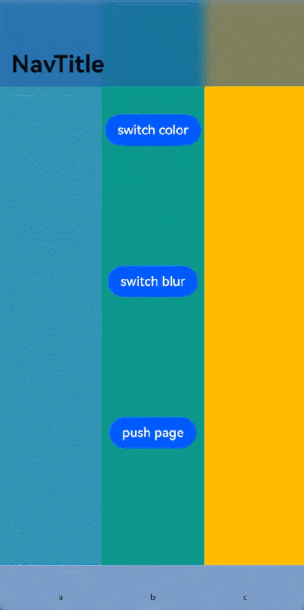HarmonyOS 鸿蒙Next 这段示例代码没有配置route_map为什么能够通过this.stack.pushPath({ name: "page" })跳转页面?
HarmonyOS 鸿蒙Next 这段示例代码没有配置route_map为什么能够通过this.stack.pushPath({ name: “page” })跳转页面?
this.stack.pushPath({ name: “page” }) 这里的“page”是哪个?怎么实现的name设定?
代码如下:
let COLOR1: string = "#80004AAF";
let COLOR2: string = "#802787D9";
let BLUR_STYLE_1: BlurStyle = BlurStyle.BACKGROUND_THIN;
let BLUR_STYLE_2: BlurStyle = BlurStyle.BACKGROUND_THICK;
@Component
struct BackComponent {
build() {
Row() {
Column() {
}
.height('100%')
.backgroundColor("#3D9DB4")
.layoutWeight(9)
Column() {
}
.height('100%')
.backgroundColor("#17A98D")
.layoutWeight(9)
Column() {
}
.height('100%')
.backgroundColor("#FFC000")
.layoutWeight(9)
}
.height('100%')
.width('100%')
}
}
@Component
struct ColorAndBlur {
@State useColor1: boolean = true;
@State useBlur1: boolean = true;
build() {
NavDestination() {
Stack({ alignContent: Alignment.Center }) {
BackComponent()
.width('100%')
.height('100%')
Column() {
Stack({ alignContent: Alignment.Center }) {
Button("switch color")
.onClick(() => {
this.useColor1 = !this.useColor1;
})
}
.width('100%')
.layoutWeight(1)
Stack({ alignContent: Alignment.Center }) {
Button("switch blur")
.onClick(() => {
this.useBlur1 = !this.useBlur1;
})
}
.width('100%')
.layoutWeight(1)
}
.width('100%')
.height('100%')
}.width('100%')
.height('100%')
}
.width('100%')
.height('100%')
// 开发者可以设置标题栏的背景颜色和背景模糊效果
.title("switch titlebar color and blur", {
backgroundColor: this.useColor1 ? COLOR1 : COLOR2,
backgroundBlurStyle: this.useBlur1 ? BLUR_STYLE_1 : BLUR_STYLE_2,
barStyle: BarStyle.STACK
})
}
}
@Entry
@Component
struct Index {
private stack: NavPathStack = new NavPathStack();
@State useColor1: boolean = true;
@State useBlur1: boolean = true;
@Builder
PageBuilder(name: string) {
ColorAndBlur()
}
build() {
Navigation(this.stack) {
Stack({ alignContent: Alignment.Center }) {
BackComponent()
.width('100%')
.height('100%')
Column() {
Stack({ alignContent: Alignment.Center }) {
Button("switch color")
.onClick(() => {
this.useColor1 = !this.useColor1;
})
}
.width('100%')
.layoutWeight(1)
Stack({ alignContent: Alignment.Center }) {
Button("switch blur")
.onClick(() => {
this.useBlur1 = !this.useBlur1;
})
}
.width('100%')
.layoutWeight(1)
Stack({ alignContent: Alignment.Center }) {
Button("push page")
.onClick(() => {
this.stack.pushPath({ name: "page" })
})
}
.width('100%')
.layoutWeight(1)
}
.width('100%')
.height('80%')
}.width('100%')
.height('100%')
}
.width('100%')
.height('100%')
.navDestination(this.PageBuilder)
// 开发者可以设置标题栏的背景颜色和背景模糊效果
.title("NavTitle", {
backgroundColor: this.useColor1 ? COLOR1 : COLOR2,
backgroundBlurStyle: this.useBlur1 ? BLUR_STYLE_1 : BLUR_STYLE_2,
barStyle: BarStyle.STACK
})
// 开发者可以设置工具栏的背景颜色和背景模糊效果
.toolbarConfiguration([
{ value: "a" },
{ value: "b" },
{ value: "c" }
], {
backgroundColor: this.useColor1 ? COLOR1 : COLOR2,
backgroundBlurStyle: this.useBlur1 ? BLUR_STYLE_1 : BLUR_STYLE_2
})
}
}

更多关于HarmonyOS 鸿蒙Next 这段示例代码没有配置route_map为什么能够通过this.stack.pushPath({ name: "page" })跳转页面?的实战系列教程也可以访问 https://www.itying.com/category-93-b0.html
.navDestination(this.PageBuilder)
里面只有一个Page. 但是参数里面有name,没写
更多关于HarmonyOS 鸿蒙Next 这段示例代码没有配置route_map为什么能够通过this.stack.pushPath({ name: "page" })跳转页面?的实战系列教程也可以访问 https://www.itying.com/category-93-b0.html
在HarmonyOS鸿蒙Next系统中,页面跳转并不完全依赖于route_map配置。虽然route_map在复杂的应用架构中用于定义页面路由和传递参数,但鸿蒙系统也支持其他方式进行页面跳转。
this.stack.pushPath({ name: "page" })这种调用方式利用了鸿蒙系统提供的页面栈管理功能。页面栈管理允许开发者在运行时动态地管理页面堆栈,包括压栈(push)和出栈(pop)操作。这种机制不依赖于route_map的静态配置,而是通过动态指定页面名称或其他标识符来实现跳转。
具体到pushPath方法,它接受一个包含页面名称的对象作为参数,并尝试将该页面压入当前页面栈中。如果目标页面已经在应用中定义并正确注册(无论是否通过route_map),系统就能够根据提供的名称找到对应的页面并实现跳转。
因此,即便没有配置route_map,只要目标页面已经在应用中正确注册,this.stack.pushPath({ name: "page" })依然能够执行页面跳转。
如果问题依旧没法解决请联系官网客服,官网地址是:https://www.itying.com/category-93-b0.html








